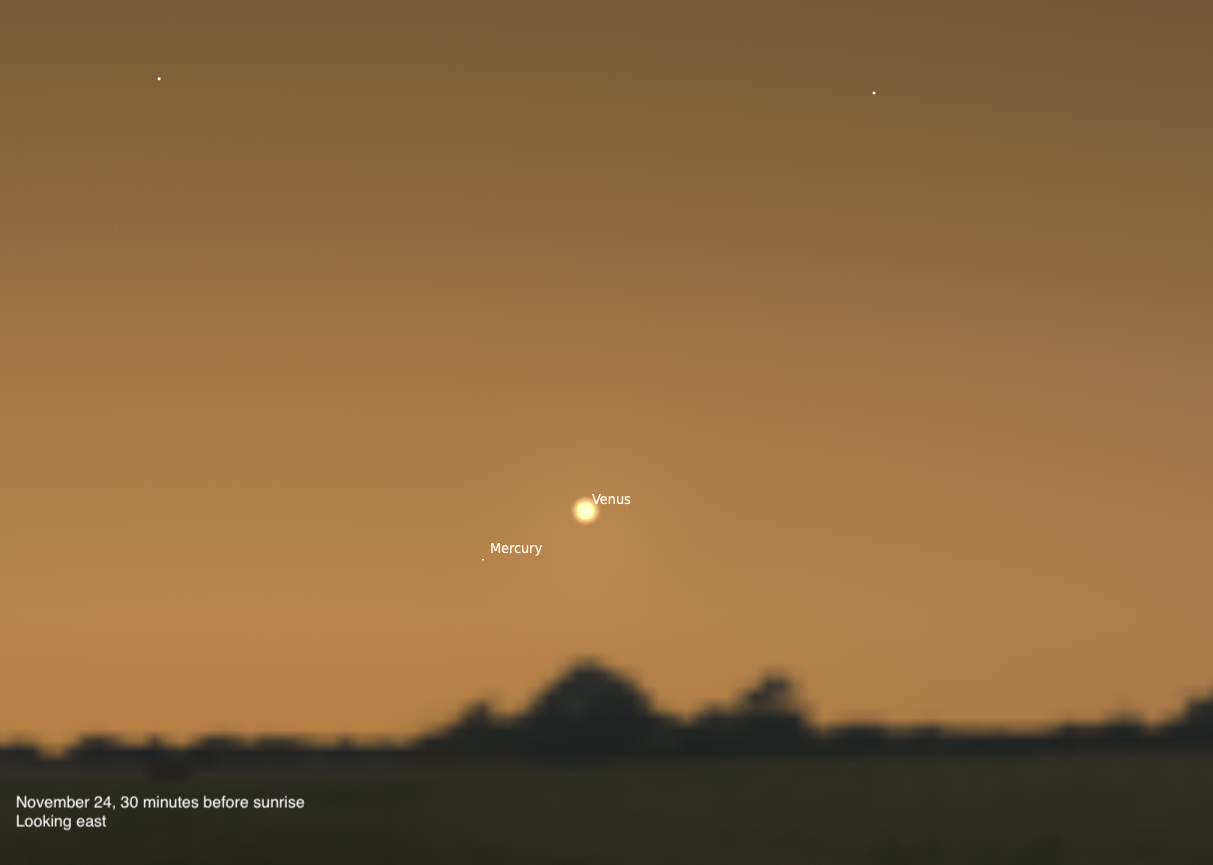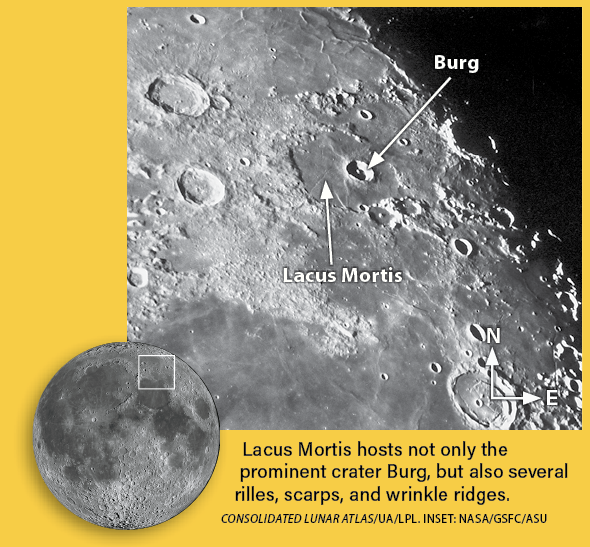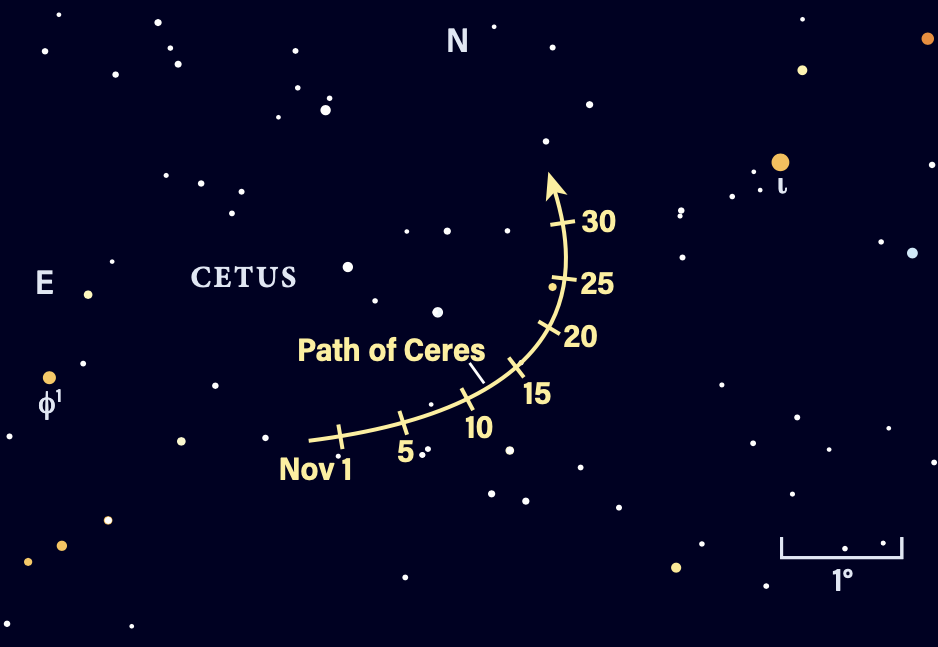Special to CosmicTribune.com, November 23, 2025
Excerpts from weekly Astronomy.com report.
Sunday, November 23
Andromeda the Princess is high in the evening sky after dark. Best known for the eponymous Andromeda Galaxy (M31), there is so much more to see in this royal domain, including the lovely edge-on spiral we’re targeting tonight: the Silver Sliver Galaxy (NGC 891).
Wait until after moonset, then pull out your telescope and point east. Look for Almach (Gamma [γ] Andromedae), shining at magnitude 2.1. The Silver Sliver is just 3.5° east of this star. Floating in a rich field of Milky Way Stars, NGC 891 glows at magnitude 9.9. That puts it within the range of small telescopes, though larger apertures will, as ever, reveal more detail. (For example, scopes 10 inches or larger should show the dark dust lane neatly bisecting the galaxy’s plane.)
True to its name, the Silver Sliver is much longer than it is wide, as we’re viewing its spiral disk edge-on. Inclined just 1.4° to our line of sight, it appears some 13’ long and only 3’ wide.
Sunrise: 6:55 A.M.
Sunset: 4:38 P.M.
Moonrise: 10:13 A.M.
Moonset: 7:03 P.M.
Moon Phase: Waxing crescent (13%)
 If you want to catch Mercury and Venus in the predawn sky, pull out binoculars to find the former, which is roughly magnitude 3. You might also be able to spot Libra’s alpha and beta stars above them. Credit: Stellarium
If you want to catch Mercury and Venus in the predawn sky, pull out binoculars to find the former, which is roughly magnitude 3. You might also be able to spot Libra’s alpha and beta stars above them. Credit: StellariumMonday, November 24
Venus and Mercury stand separated by 1.5° in the early-morning sky, visible in the east about half an hour before the Sun rises. The catch is that while bright magnitude –3.9 Venus is readily spotted with the naked eye, Mercury is only magnitude 2.9 and will need binoculars to spot.
This morning, Mercury is located just to the lower left of Venus. Above them are Alpha (α) and Beta (β) Librae, fading quickly in the growing twilight. The two planets will rise as sunrise approaches, but the sky will also brighten accordingly.
If you have a telescope, you can view the planets’ disks as well. Mercury shows off a 9”-wide disk, of which only a thin crescent is illuminated, just 7 percent lit. Venus’ disk is only a little larger — 10” — but shows the opposite phase, a gibbous that is nearly fully illuminated at 98 percent lit.
Make sure to put away any optics at least several minutes before sunrise from your location, which may differ from the time given below.
Mercury will pass 1.1° north of Venus at midnight EST tonight. If you step outside tomorrow morning (the 25th) at the same time (30 minutes before sunrise), Mercury will stand 1.4° to Venus’ upper left and appear slightly brighter, at magnitude 2.1.
 By November 25, Mercury has moved to stand above Venus in the eastern sky before dawn; the smaller planet now shines at magnitude 2.1. Credit: Stellarium
By November 25, Mercury has moved to stand above Venus in the eastern sky before dawn; the smaller planet now shines at magnitude 2.1. Credit: StellariumSunrise: 6:56 A.M.
Sunset: 4:37 P.M.
Moonrise: 10:55 A.M.
Moonset: 8:05 P.M.
Moon Phase: Waxing crescent (21%)

Tuesday, November 25
The Moon passes 0.4° north of Pluto at 9 A.M. EST, though neither is visible at that time.
By evening, our satellite is a nearly six-day-old crescent, sinking slowly in the southwest after dark. It’s located in western Capricornus. Sunrise is slowly making its way across the lunar landscape, lighting up Lacus Mortis, the Lake of Death, just northeast of Mare Serenitatis, whose eastern portion is now illuminated.
Lacus Mortis has a diameter of nearly 100 miles (160 kilometers) and has a roughly hexagonal shape. Although it began as a crater, the lunar surface beneath it fractured and filled with lava, which created its smooth, dark floor. That floor still holds signs of geologic activity, including a rille, or channel, in its southwestern region that formed as the ground there pulled apart.
Located within the Lake is the prominent bowl-shaped crater Burg, which stretches about 25 miles (40 km) across. Note its distinct central peak and slumped outer walls.
Sunrise: 6:57 A.M.
Sunset: 4:37 P.M.
Moonrise: 11:30 A.M.
Moonset: 9:11 P.M.
Moon Phase: Waxing crescent (29%)
Wednesday, November 26
Jupiter passes 7° south of Pollux at 2 A.M. EST. By 9 P.M. local time this evening, the giant planet stands about 10° above the eastern horizon, visible to the lower right of Gemini’s twin stars, Castor and Pollux. Of those stars, Castor is higher and appears slightly bluer, while Pollux has more of an orange-yellow hue and hangs below it.
Through a telescope, Jupiter’s disk stretches 44” wide, offering visible details including alternating dark and light belts of clouds. Later tonight, the Great Red Spot will rotate onto the disk, reaching roughly midway across around 1 A.M. EST on the 27th (late on the 26th for the western half of the U.S.).
Jupiter’s four Galilean moons are stretched out in a line, all west of the planet. Closest is Io, followed by Europa, Ganymede, and Callisto. As the hours pass, Io approaches Jupiter’s western edge, winking out of visibility around 1:15 A.M. EST (again, early on the 27th for the Eastern and Central time zones). At this time, the moon is still some 20” from the planet’s limb, but disappears because it has passed into Jupiter’s long, dark shadow, which stretches far to the west. Unseen, Io passes behind the planet’s disk proper about an hour later.
If you continue observing into the early-morning hours of Thursday, you can watch Io reappear at Jupiter’s eastern limb around 4:30 A.M. EST on the 27th.
Sunrise: 6:58 A.M.
Sunset: 4:37 P.M.
Moonrise: 12:00 P.M.
Moonset: 10:17 P.M.
Moon Phase: Waxing crescent (39%)
 Ceres follows a gently curving path through Cetus the Whale this month, bracketed by a few bright stars. Credit: Astronomy: Roen Kelly
Ceres follows a gently curving path through Cetus the Whale this month, bracketed by a few bright stars. Credit: Astronomy: Roen KellyThursday, November 27
Dwarf planet 1 Ceres stands stationary at 6 P.M. EST in the constellation Cetus the Whale. Previously moving westward, or retrograde, after today the dwarf planet will now turn and begin moving prograde (eastward) against the background stars.
Eighth-magnitude Ceres is visible as soon as it’s dark, floating above the southeastern horizon. Tonight it lies near 3rd-magnitude Iota (ι) Ceti, just 2° southeast of this star. You can scan the sky with either binoculars or a telescope, either should pick up Ceres’ glow. Use the chart above to aid you.
Also within Cetus the Whale is the “wonderful” variable star Mira (Omicron [ο] Ceti). A known long-period variable star, Mira’s brightness changes over the course of nearly a year, swinging from 2nd to 10th magnitude, in and out of visible range. According to the American Association of Variable Star Observers, Mira is currently around mid-8th magnitude, roughly the same brightness as Ceres. It will also require binoculars or a telescope to view — see if you can find it tonight, far east of Ceres’ position and about 6° southwest of 4th-magnitude Delta (δ) Ceti.
Sunrise: 6:59 A.M.
Sunset: 4:36 P.M.
Moonrise: 12:25 P.M.
Moonset: 11:25 P.M.
Moon Phase: Waxing crescent (49%)
Friday, November 28
First Quarter Moon occurs this morning at 1:59 A.M. EST. At this phase, the Moon is not visible in the morning, but rises in the afternoon and remains in the sky all evening, setting around local midnight.
Saturn comes to a stationary point in our sky tonight at 8 P.M. EST in the constellation Aquarius. At 8 P.M. local time, the ringed planet is some 40° high in the south, shining at magnitude 0.9. You can’t miss it, as it’s the brightest point of light in this region of the sky, hanging below the Circlet asterism of Pisces the Fish and far to the upper left of magnitude 1.2 Fomalhaut, the brightest star in this part of the sky. The waxing Moon is just to Saturn’s lower right, also in Aquarius this evening.
Through a telescope, Saturn’s disk spans 18”, while its rings stretch 41” along their long axis. The ring system is tilted just 0.4° to our line of sight, so the rings appear virtually edge-on. If you’re observing at 8 P.M. EST, 10th-magnitude Rhea, Tethys, and Dione are visible near the planet. Rhea is alone to the east, while Dione is slightly closer than Tethys to the west. Titan, the brightest moon, is mid-8th magnitude and now sits far west of the planet after transiting earlier this week; it is located some 2’ from the planet’s center.
The light of the nearby Moon will likely make it difficult to spot any of Saturn’s other, smaller moons, as they are fainter than 10th magnitude.
Sunrise: 7:00 A.M.
Sunset: 4:36 P.M.
Moonrise: 12:49 P.M.
Moonset: —
Moon Phase: Waxing gibbous (59%)

You must be logged in to post a comment Login